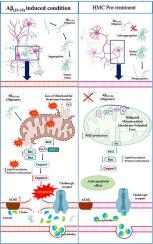Bioorganic & Medicinal Chemistry ( IF 3.3 ) Pub Date : 2023-11-18 , DOI: 10.1016/j.bmc.2023.117536 Sakthivel Jafni 1 , Sethuraman Sathya 1 , Malaisamy Arunkumar 2 , Chandramohan Kiruthiga 1 , Mahalingam Jeyakumar 1 , Easwaran Murugesh 3 , Kasi Pandima Devi 1

|
In the present study, we evaluated the neuroprotective potential of Hesperidin Methyl Chalcone (HMC) against the neurotoxicity induced by Aβ(25-35) peptide. HMC demonstrated higher free-radical scavenging activity than Hesperidin in initial cell-free studies. Investigations using the fluorescent dye thioflavin T with Aβ(25-35) peptide showed that HMC has the ability to combat extracellular amyloid aggregation by possessing anti-aggregation property against oligomers and by disaggregating mature fibrils. Also, the results of the molecular simulation studies show that HMC ameliorated oligomer formation. Further, the anti-Alzheimer’s property of HMC was investigated in in vitro cell conditions by pre-treating the neuro 2a (N2a) cells with HMC before inducing Aβ(25-35) toxicity. The findings demonstrate that HMC increased cell viability, reduced oxidative stress, prevented macromolecular damage, allayed mitochondrial dysfunction, and exhibited anticholinesterase activity. HMC also reduced Aβ induced neuronal cell death by modulating caspase-3 activity, Bax expression and Bcl2 overexpression, demonstrating that HMC pre-treatment reduced mitochondrial damage and intrinsic apoptosis induced by Aβ(25-35). In silico evaluation against potential AD targets reveal that HMC could be a potent inhibitor of BACE-1, inhibiting the formation of toxic Aβ peptides. Overall, the findings imply that the neuroprotective efficacy of HMC has high prospects for addressing a variety of pathogenic consequences caused by amyloid beta in AD situations and alleviating cognitive impairments.
中文翻译:

橙皮苷甲基查尔酮可减少细胞外 Aβ(25-35) 肽聚集和纤维颤动,并保护 Neuro 2a 细胞免受 Aβ(25-35) 诱导的神经元功能障碍
在本研究中,我们评估了橙皮苷甲基查耳酮 (HMC) 对 Aβ (25-35)肽诱导的神经毒性的神经保护潜力。在最初的无细胞研究中,HMC 表现出比橙皮苷更高的自由基清除活性。使用荧光染料硫黄素 T 和 Aβ (25-35)肽进行的研究表明,HMC 具有针对低聚物的抗聚集特性和解聚成熟原纤维,从而能够对抗细胞外淀粉样蛋白聚集。此外,分子模拟研究的结果表明,HMC 改善了低聚物的形成。此外,通过在诱导 Aβ (25-35)毒性之前用 HMC 预处理神经 2a (N2a) 细胞,在体外细胞条件下研究了 HMC 的抗阿尔茨海默病特性。研究结果表明,HMC 增加细胞活力,减少氧化应激,防止大分子损伤,减轻线粒体功能障碍,并表现出抗胆碱酯酶活性。 HMC 还通过调节 caspase-3 活性、Bax 表达和 Bcl2 过表达来减少 Aβ 诱导的神经元细胞死亡,这表明 HMC 预处理可减少 Aβ 诱导的线粒体损伤和内在细胞凋亡(25-35)。针对潜在 AD 靶标的计算机评估表明,HMC 可能是 BACE-1 的有效抑制剂,抑制有毒 Aβ 肽的形成。 总体而言,研究结果表明,HMC 的神经保护功效在解决 AD 情况下β淀粉样蛋白引起的各种致病后果和减轻认知障碍方面具有很高的前景。






























 京公网安备 11010802027423号
京公网安备 11010802027423号